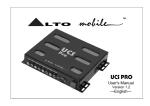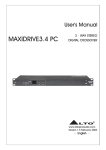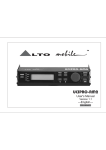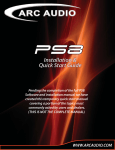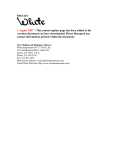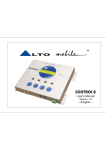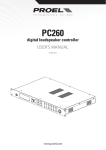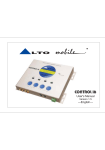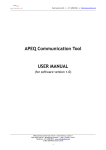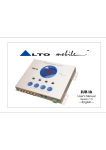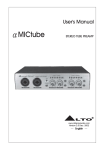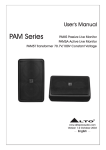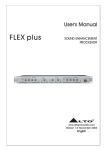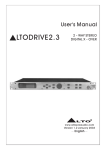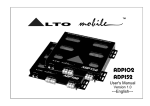Download TOTAL RECALL - Eb Acoustic
Transcript
TM LTO TOTAL RECALL User's Manual Version 1.0 ---English--- TM LTO Introduction Dear Customer, Thank you for choosing the ALTO MobileTM TOTAL RECALL digital multichannel sound processor. We hope you will enjoy using this product as much as we enjoyed developing it. The Alto Mobile range is the result of considerable research and development in our R&D centers in Europe and the Far East. It is a very close cousin of ALTO's professional digital signal processors. We've been designing products for musicians and recording studios for a long time, so the car audio product you now have in your hands has an unusually fine pedigree. The passenger cabin of a vehicle is worlds away from the controlled listening environment of the recording studio, and yet many of the same sound processing techniques can be applied with spectacular success. ALTO MobileTM is a specialist division of audio and computer software engineers, but above all we are car audio enthusiasts who love the challenge of trying to reproduce studio quality sound inside a moving vehicle. Products such as the one you now own help to make this possible. If you've not yet had TOTAL RECALL installed in your vehicle, that is obviously the first thing you will need to do. We strongly recommend that you have the unit professionally installed and set-up by a specialist company authorized by the ALTO MobileTM distributor in your country. The installation instructions in this manual are not intended to be a thorough explanation of all the steps involved in correctly fitting and setting up this unit. The instructions assume that the person installing the equipment has been trained to carry out such work. You are an important member of our team. We listen to what our customers say and take on board their suggestions. It is this feedback that helps us create the products you want. So if you have any comments, please let us know via email to "[email protected]". THE ALTO MOBILETM TEAM Care & Safety Instructions TM LTO All the safety and operating instructions should be read before this product is installed and operated. We IMPORTANT recommend that installation be carried out by an authorized mobile electronics installation company. Please contact your local ALTO MobileTM distributor for a list of authorized installers in your area. DO NOT DISASSEMBLE: No user serviceable parts inside; refer servicing to qualified personnel only. WATER & MOISTURE: The equipment should be protected from moisture and rain, especially if mounted in the vehicle's trunk area or any location that may be susceptible to water ingress. PRODUCT LOCATION: The equipment should be situated so that its location does not interfere with safe driving of the vehicle. Avoid locations close to safety air bags. Ensure proper ventilation. The product should not be situated under carpeting or in a totally sealed enclosure. Partly enclosed equipment racks should be well ventilated, using forced air cooling fans if necessary. Locate away from heat sources such as engine exhaust systems and coolant radiators. POWER SOURCE & GROUNDING: This product is designed only for vehicles with a 12 VOLT NEGATIVE GROUND electrical circuit. This product may be damaged if used in vehicles with a 24 Volt supply or a positive ground electrical circuit. ELECTRICAL CONNECTION: Improper electrical wiring may invalidate the product warranty and/or the vehicle warranty. Installation should only be undertaken by a qualified automotive electrician, preferably MECP qualified or local equivalent. CARE & CLEANING: Clean only with a dry cloth. Avoid sharp objects from making contact with the casing. SERVICING: If a malfunction occurs, the equipment should be serviced only by qualified personnel. Return to the dealer who supplied you with the unit. Critical components should only be replaced with factory parts or recommended equivalents. TM Block Diagram LTO TOTAL RECALL - BLOCK DIAGRAM HPF FRONT LEFT IN 1 ADC DELAY FRONT RIGHT IN 2 ADC DELAY REAR LEFT IN 3 ADC DELAY REAR RIGHT IN 4 ADC DELAY HPF HPF HPF 1 LPF DELAY 10GEQ 10GEQ 10GEQ 10GEQ 3PEQ 3PEQ 3PEQ 3PEQ 3PEQ MULTI COMP GAIN MULTI COMP GAIN MULTI COMP GAIN MULTI COMP GAIN COMP/LIMT METER POLARITY COMP/LIMT COMP/LIMT POLARITY FRONT LEFT MUTE DAC OUT 2 FRONT RIGHT MUTE DAC OUT 3 REAR LEFT MUTE DAC OUT 4 REAR RIGHT MUTE DAC OUT 5 SUB-WOOFER OUT 6 SUB-WOOFER METER POLARITY GAIN OUT 1 METER POLARITY COMP/LIMT DAC METER POLARITY COMP/LIMT MUTE METER TOTAL RECALL is a 4 input, 6 output device offering several forms of signal processing, as outlined in the above block diagram. 1 The Front Left & Right Channels are summed (i.e. mixed together) to provide an additional mono Subwoofer channel with its own independent set of editable parameters. This is then split at the output to provide two identical mono bass outs (5 & 6). TM Opening Screen (PC Editor) 1 LTO 2 3 4 5 6 7 8 A Windows compatible PC Editor is available for free download from our web site. To get a copy, go to http://www.altomobile.com/html/support_forum.html and click on the link "Data Resources / Downloads" and then "Software Downloads". R USEFUL TIP When you launch the software editor on your PC, you will see the opening screen above (later software versions may differ). Each of the numbered sections is explained in the following pages - just look for the number icons within the text. TM Parameter Menus & System Set-up LTO There are no controls on TOTAL RECALL itself. The various parameters are adjusted by attaching the unit to a suitable Personal Computer running our dedicated Windows compatible PC Editor software (available as a free download from our website at www.altomobile.com). R Hook-up to the computer is achieved with TOTAL RECALL's 9-pin RS232 serial interface port, which is located on the same side as the audio input/output terminals. IMPORTANT The large 25-pin socket on TOTAL RECALL is ready for the optional hardware Programmer. Do not attempt to connect your PC to the 25-pin port - damage may result if you do. If you have had your TOTAL RECALL professionally installed and set-up for you, there should be no need to alter any settings. The unit features a password access system that your installer may have set in Lock mode to safeguard the settings. Connection to the PC (RS232, 9-pin socket) The RS232 port allows incoming and outgoing communication between TOTAL RECALL and a PC. Real-time control and set-up is possible. Set-ups made using the PC EDITOR can be saved as a PRESET configuration and downloaded to the TOTAL RECALL, where it is then stored in the unit's internal non-volatile memory. Settings stored in TOTAL RECALL can also be uploaded to the PC for editing. 1] Ensure that power to TOTAL RECALL and the computer is switched OFF. 2] Connect TOTAL RECALL to the PC's RS232 serial port using a data cable with 9-pin female plugs. The required data cable is known as a 'null modem' (also data transfer) type serial interface cable (this is normally supplied with the TOTAL RECALL). Attach the other end to the socket situated next to the signal Output terminals of TOTAL RECALL. 3] Turn on your audio system, including TOTAL RECALL. Now boot-up your computer and run the PC EDITOR (see "First Steps with the PC EDITOR"). USEFUL TIP For commands that allow set-up of the RS232 interface, look under OPTIONS in the FILE menu. Select the Rs232 tab. TM Parameter Menus & System Set-up LTO Rs232 > Port: Shows the current Rs232 port (COM) used by the PC EDITOR and allows other choices to be selected, if available on your computer. Rs232 > BAUD RATE: Provides options to select the communication speed. IMPORTANT Reliable data transmission can usually be expected as long as the cable length is not more than 5 meters. ADVANCED TIP The RS232 serial port default speed is 9600 bits per second. In the OPTIONS menu it is possible to set a speed of up to 115200 bits per second. If you experience transmission problems or disconnection, reduce the speed of the serial data transmission. First Steps with the PC EDITOR To avoid accidentally overwriting an existing PRESET, it is important that you follow the correct routine when initiating a session between TOTAL RECALL and your computer. 1] With TOTAL RECALL powered up and connected to your PC's serial port as described, Run the PC EDITOR program by selecting the Tr EDITOR icon in the Windows PROGRAMS menu. R 2] The PC EDITOR should now be loaded. A welcome screen will appear. This closes after 5 seconds (or click on it). Select NEW from the FILE menu. You will be presented with 2 options - NEW UNIT and NETWORK SCAN. If your TOTAL RECALL has already been installed and set-up and you now wish to view and/or modify some parameters, do the following: Select NETWORK SCAN. The program will scan your PC's serial ports. When Done, it will present a list of IDs. The ID number of TOTAL RECALL is 1 (this cannot be changed). The ID list will show if TOTAL RECALL (ID 1) is correctly connected or not. Pressing OK will prompt the system to retrieve (UPLOAD) all the parameters and all previously saved USER PRESETS from TOTAL RECALL to your computer. Awindow will automatically open on your computer screen. You can now view the settings and edit them (depending on the Lock mode). TM LTO Parameter Menus & System Set-up If your TOTAL RECALL has not been set-up yet, or if you want to replace the existing set-up, you can create a new named profile (NEW UNIT) within the PC EDITOR. Here's how: Select NEW UNIT. In the window that appears, type a new name for the unit you are creating (this is optional). The GANGING* option should generally be left at its default setting (unchecked). Press OK and a window corresponding to the unit you have just named will open up with the DEFAULT configuration and the block diagram. Choose ONLINE from the ACTIONS menu and the PC will scan the serial port to verify that TOTAL RECALL is correctly connected. The NETWORK SCAN window should show the system status (UNIT CONNECTED or NOT CONNECTED). Pressing OK will cause all the parameters set in the PC to be downloaded to the TOTAL RECALL. The ONLINE icon will appear. USEFUL TIP *Ganging: The stereo outputs may be "ganged" (linked together) as Front and Rear stereo pairs, so that changes are simultaneously applied to both channels. This is achieved via the MODIFY UNIT option in the ACTIONS menu of the PC EDITOR. However, if you intend to use the channel delay function for speaker 'time alignment' then you should NOT gang the channels. Every time a DOWNLOAD is made to the TOTAL RECALL, the USER PRESETS in the internal memory are overwritten. Selecting OFFLINE from the ACTIONS menu will cause the PC to be disconnected from the TOTAL IMPORTANT RECALL. Be aware that selecting ONLINE again will prompt the program to perform a new scan of the network and automatically DOWNLOAD the settings from the PC to TOTAL RECALL. If you do not wish this to happen, then you must initiate a new session by Closing the current window and then selecting NETWORK SCAN (File > New > Network Scan) so that TOTAL RECALL UPLOADS to the PC. Every time an UPLOAD is made, all the USER PRESETS stored in TOTAL RECALL are transferred to the corresponding positions within the PC EDITOR. Parameter Menus & System Set-up TM LTO Edit Mode (Password Protection) TOTAL RECALL incorporates a password system and your installer may have set a password to ensure that vital settings are not altered. In this case you will NOT be able to alter parameters via the PC EDITOR. In the PC EDITOR, select FILE > OPTIONS and then the LOCK tab. This will present you with a menu. Full Edit: This is the DEFAULT mode. No password is set at the factory. From here you can lock the unit by clicking within the empty Total Lock button. A text box will open, allowing you to enter a password of your own choice. Click OK. It is important that you remember this password. Total Lock: In this mode, no editing is allowed. To enable Total Lock, a password must be entered as above. To disable the lock, click within the empty Full Edit button. A text box will open. Type the password used to set lock mode. Press OK. Help File The HELP FILE accessible from within the PC EDITOR will be updated as necessary. Since software updates after the printing of this manual may affect the instructions provided here, please check the Help File for any later remarks. Introduction to the PC EDITOR Click on one of the icons on the welcome screen (system block diagram) of the PC EDITOR. A window will appear showing one of several 'pages' where you can set the parameters using virtual knobs and sliders or by typing the values. Here is a brief overview of the various 'pages' that make up the TOTAL RECALL PC EDITOR. Each is explained in more detail in the next section. 2 CHANNEL DELAY: Allows a delay to be applied in order to "time align" each output channel. Includes a graphical interface of 5 virtual speakers. 3 HIGH PASS/LOW PASS FILTERS (HPF & LPF): A High-Pass filter may be applied independently to each of the Front and Rear channels. A Low-Pass filter may be applied to the Subwoofer channel. TM LTO Parameter Menus & System Set-up 4 GRAPHIC EQUALIZATION (GEQ): Each of the Front and Rear channels has a digital 10-band graphic equalizer. 5 PARAMETRIC EQUALIZATION (PEQ): Each of the channels (including the Subwoofer channel) has a fully variable 3-band parametric equalizer. 6 DYNAMIC EQUALIZATION (MULTI COMP): Each of the Front and Rear channels has a function we call Dynamic EQ. This allows the full audio band to be digitally split into three separate high, mid and low bands. The level in the high and low bands can then be set to change independently as the overall input level (determined by the position of your CD player's volume control) is adjusted. 7 GAIN CONTROL SECTION: Allows the output LEVEL and channel signal PHASE (polarity) to be adjusted. Also allows channels to be MUTED (i.e. switched out). 8 DYNAMIC GAIN CONTROL (LIMITER): Each channel has its own independent COMPRESSOR/LIMITER. Careful setting of the parameters will help to maintain a more consistent and pleasurable listening level and extend the performance of your speakers. GLOBAL: this window shows the response curves of all channel outputs and provides a convenient overview of your settings. PRINT: Not a 'page' like those above, but an important function worth highlighting here. From the FILE menu, selecting PRINT provides a print-out of all the parameters of the TOTAL RECALL, together with the GLOBAL graph. View it before printing by selecting PRINT PREVIEW. Parameter Menus & System Set-up TM LTO TOTAL RECALL Features Explained 2 CHANNEL DELAY (TIME ALIGNMENT) A wide ranging amount of time delay, from as little as 21 microseconds (0.021ms, equivalent to a distance of a little over 7mm), can be set on each of the channels. This is commonly known as 'Time Alignment'. Values can be input as distance (millimetres/meters) or time (microseconds/milliseconds). The amount of delay is usually calculated from physical measurements of the distances between the various speakers and the driver's ears. The delay compensates for the difference in speaker mounting positions, with the speaker furthest away (commonly the woofer in the trunk) being the reference point to which all other speakers are aligned (delayed). When applied correctly to all speakers in the system, the result is an improvement in the apparent stage position, height, depth and the location and focus of the performers on the 'virtual stage' that extends across the dashboard. There should also be the feeling that the low bass is coming from ahead of you, even where the woofer is physically behind you. ADVANCED TIP Temperature Compensation: This allows the current in-car temperature to be keyed in. The system uses this value to compensate for any variation in the speed of sound when calculating time delay. This is a feature carried over from the pro audio version of the software and is more applicable to PA applications, in which it allows the delays to be set during the sound-check and quickly adjusted at the time of the concert if necessary. It can also be useful in some automotive situations. 3 HIGH PASS/LOW PASS FILTERS (HPF & LPF): TOTAL RECALL is equipped with independent High-Pass filters for each of the Front & Rear channels, and a Low-Pass filter for the Subwoofer channel. For each filter there are 9 filter type/slope options: Butterworth type with 6dB, 12dB, 18dB or 24dB per octave slope Bessel type with 12dB, 18dB or 24dB per octave slope Linkwitz-Riley type with 12dB or 24dB per octave slope The different filter characteristics can be seen on the PC EDITOR's graphical display. The filter point can be set between 16Hz and 16kHz, or each filter can be bypassed by selecting THRU. TM LTO Parameter Menus & System Set-up Phase: The Sub (Subwoofer) channel provides fine control of the signal's phase, in 5 degree steps. When combined with the 180 degrees polarity switch, it is possible to adjust the phase in the bass region through a full 360 degrees. IMPORTANT ADVANCED TIP Which filter type, slope and frequency you should choose will depend on the speakers you are using. Since it is important to set-up filter points carefully to maximise speaker power handling and avoid damage, this is usually best left to a professional car audio installer. When making fine adjustments to signal phase in the bass region, bear in mind that phase is related to frequency. You cannot "phase-align" the entire low-frequency band, but you can align the phase of two woofers at 50Hz, for example, or whatever frequency you choose. Where dual woofers (one handled through TOTAL RECALL, the other not) are causing cancellation because of different mounting positions and/or mounting angles and/or vent characteristics, aligning their phase can substantially improve SPL (sound pressure level) and clarity of bass. 4 GRAPHIC EQUALIZATION (GEQ): Each of the Front and Rear channels has a digital 10-band graphic equalizer. This type of equalizer has a fixed center point and bandwidth. Gain is adjustable by +/- 15dB. The frequency centers are set at 31, 63, 125, 250, 500, 1000, 2000, 4000, 8000 & 16000Hz. Use the "Ch Select" list to switch the display. An "ON/OFF" button allows instant comparisons of the sound with and without equalization applied, while all frequency points can be set flat simply by clicking the "Reset" button. 5 PARAMETRIC EQUALIZATION (PEQ): 3-band full parametric equalization is provided on each of the channels. With this type of equalizer, frequency, gain and bandwidth are all variable. In addition, TOTAL RECALL allows you to select from a list of different EQ contours. Freq: The center frequency of each band can be set between 16Hz and 16,000Hz. Gain: The level at the chosen center frequency can be increased or reduced by 15dB. Band: This dictates how the frequencies next to the center frequency will be affected during Gain boost or cut. With a narrow bandwidth (minimum 0.05 octave), frequencies other than the center frequency and its immediate neighbours will Parameter Menus & System Set-up TM LTO be largely unaltered. With a broad bandwidth (maximum 3 octaves), gain changes will be spread more widely. The effect can be seen on the PC EDITOR's real-time graph. Type: This section allows several types of EQ contour to be applied. Depending on the EQ Type selected, certain parameters (Gain, Bandwidth) are automatically set (they become greyed out). Peaking - The default setting is the traditional parametric mode, allowing gain cut or boost at and around the chosen center frequency. LowSh6 - This creates a shelved response with a 6dB/octave slope, with the frequency shift occurring towards the lower end of the frequency scale. Bandwidth adjustment is disabled in this mode. LowSh12 - A shelved response as above but with a 12dB/octave slope. HiSh6 - This creates a shelved response with a 6dB/octave slope, with the frequency shift occurring towards the higher end of the frequency scale. Bandwidth adjustment is disabled in this mode. HiSh12 - A shelved response as above but with a 12dB/octave slope. Notch - The Notch filter effectively removes a slice of the signal and is useful for targeting very localised problems. It can, for example, be used as an aid to tracing spurious noises caused by vibrating panels being excited at a certain frequency. Gain adjustment is disabled in this mode. 6 DYNAMIC EQUALIZATION (MULTI COMP): Apart from simple stereo graphic equalizers, most of the more advanced car audio signal processors either include, or are designed to feed, multichannel electronic crossovers. These in turn feed multiple amplifier channels driving separate bass, mid and high frequency component type speakers. TOTAL RECALL is different. Firstly, TOTAL RECALL has 4 independent inputs feeding 5 independent output channels. But what really makes it different is that it's designed for use with full-range speaker systems that are either actively driven (i.e. the power amplifier stage is part of the speaker itself or forms a matched package that cannot be separated), or speaker systems that use passive crossovers after the power amplifier stage. In these situations, the processor must feed a full-range signal from its outputs, rather than separated mid, high and low bands. However, it is still possible to customise the sound in specific frequency bands thanks to TOTAL RECALL's unique Dynamic Equalization feature. TM LTO Parameter Menus & System Set-up What drives this Dynamic EQ feature is known in pro audio circles as a multiband compressor. It provides the ability to digitally split the full-range audio input signal on each of the Front and Rear Channels into low, mid and high bands and set some parameters that will cause the gain in the high and low bands to adjust automatically (that is, dynamically) in response to a change in the input level. What this means is that the shape of the overall frequency curve will change according to the signal level at the input, as typically dictated by the position of your CD player's volume control. Band split points, level threshold and gain adjustments are all variable for each channel. Threshold: Allows setting of the level above which the gain adjustment will start to operate. Below this point, the signal is unaltered. Gain: Here you set the initial level of the band, in the range +/- 18dB. The boost or cut has what is known as a "shelving" response, which describes an initial sloped response which then flattens out rather like a shelf, boosting (or cutting) all frequencies across the remainder of the band by the same amount. You can set a High and/or Low boost that will reduce back to the original curve as the input level exceeds the Threshold you have set. Freq: Here you set the frequency that becomes the split point for the band. For the High band, the split point can be set between 2kHz and 16kHz. For the Low band, the split point can be set between 63Hz and 1kHz. This creates also a Mid band that spans the frequencies between the upper and lower split points. Ratio: The value selected here dictates how strongly the level is controlled when it exceeds the Threshold point you set. The range is 1.1 to 20.0. This is a dB value representing the amount of level increase at the input that will result in a 1dB increase at the extreme high/low frequency point of the band. A sloping response curve is applied from the band split point. So for example, selecting a value of 6.0 in the High band will mean that for every 6dB increase at the input, the output at around 20kHz (i.e. the extreme high frequency point of that band) will rise by approximately 1dB. Other frequencies within the band will be less heavily compressed. This retains the sloping response curve that gives a natural roll-off rather than any sudden level change at the band split point. Attack: A time value in milliseconds. This sets how quickly the Dynamic EQ will kick in after the Threshold level has been exceeded. Set faster for higher frequencies, slower for bass frequencies. Parameter Menus & System Set-up TM LTO Release: A time value in milliseconds and seconds. This sets how quickly the Dynamic EQ will switch out when the signal level returns below the Threshold. Set faster for higher frequencies, slower for bass frequencies. ADVANCED TIP ADVANCED TIP The Attack and Release speeds need to be adjustable in order to avoid any audible pumping that can sometimes occur on bass frequencies. There are several ways in which Dynamic EQ can be applied to improve performance linked to volume level, but perhaps the most common is to create a Loudness Contour. This is a widely used frequency response contour that lifts the level of low and high frequencies to compensate for the ear's reduced sensitivity at low volume. In the car it also greatly helps to counteract the masking effect of road and engine noise. It is important that the loudness boost reduces as the volume level increases. This can be achieved with the Dynamic EQ function. 7 GAIN CONTROL SECTION: TOTAL RECALL has no analog input or output gain controls - output level adjustment is handled entirely in the digital domain. The input stage will accept a maximum unclipped input level of 2V rms. Click on one of the virtual output level slide controls with your PC's left mouse button and hold the button down as you move the virtual slider up or down with your cursor control. Alternatively, you can enter a dB value directly into the text box below the slider (type a value and then press ENTER). Clicking on a MUTE button, which will then turn red, will switch out that channel (useful during fault finding and system set -up). Channel signal PHASE (polarity) can be set to 0 or 180 degrees. This can sometimes improve stereo imaging where speakers are mounted substantially off-axis. It can also provide a "quick fix" if you find you've wired speakers out of phase! USEFUL TIP The input stage of TOTAL RECALL will accept an unbalanced signal that is typical of many aftermarket head units (CD players etc.). Where you have a requirement to feed a high level, speaker level or balanced type signal from your head unit, use the optional Alto Mobile UI-4 universal input interface. TM LTO Parameter Menus & System Set-up 8 DYNAMIC GAIN CONTROL (LIMITER): Each channel has its own independent COMPRESSOR/LIMITER, allowing you to determine the amount of level gain (i.e. increase in volume) above a threshold point that you set. This helps maintain a more consistent listening level and both protects and extends the performance of your speakers. Output levels and the amount of gain reduction are displayed on the PC screen in real-time as an aid to system set-up. Threshold: Allows setting of the level above which the Comp/Limiter intervenes (compressing or limiting the signal) and below which it leaves the signal unchanged. Atk/Rel: There is a choice of 3 reaction speeds combining attack and release times. You can choose whether the Comp/ Limiter reacts more rapidly or slower than the default NORMAL setting when the signal exceeds or drops below the threshold. Set faster for high frequencies, slower for bass frequencies. For Front & Rear full-range systems, the NORMAL setting will generally be the optimum one. For the Sub channel, the SLOW setting will usually be best. Ratio: The Ratio function is similar to that in the Dynamic Equalization section, but with the addition of a LIMITER value. This value prevents the channel output from increasing by more than 1dB no matter how much the level rises at its input. USEFUL TIP How we use a compressor/limiter in a car is similar to the way broadcasters use them. Like the radio station, we get our music delivered mostly on Compact Disc, so a degree of compression will have already been applied at the recording stage. But the recording studio sound engineer has to ensure that he doesn't make a $10,000 audio system sound like a $500 one. He has to be careful not to compress too much. This means that the dynamic range from the CD will often still be too much for both broadcast use and playback at high power on a car audio system. So, like the radio stations, we tailor the sound some more by applying our own additional processing. There are two things we are trying to achieve when we add compression or limit the signal. Firstly we want to protect the speakers (and to a lesser degree the power amps) from exceeding their capabilities. They will sound better (less distortion) and live longer. The second thing is that we want to be able to free ourselves from having to constantly tweak the volume level. Road and engine noise has a habit of masking parts of the music, and at those times we turn it up. Then in comes that Clapton guitar solo and we grab the volume control and spin it down before our ears begin to hurt! Parameter Menus & System Set-up TM LTO What our processor allows us to do is set our preferred upper level - it's like having your own DJ poised with her hand over the volume control, ready to turn it down when the music gets uncomfortably loud. And because we have this to automatically control things for us at the top end, we can raise the overall volume level, which increases the level of the softer musical passages. ADVANCED TIP If you would like more information on Dynamic Gain Control and compressor/limiting, including set-up advice, please visit our web site support forum where you will find a technical paper available for download. Working with Presets At the lower edge of the PC EDITOR window is a series of commands for recalling and storing PRESETS. To load a PRESET: Click on RECALL and then on one of the numbered red (FACTORY) or green (USER) PRESET buttons. The selected PRESET will be loaded and its name displayed in the text box. To save a PRESET: Click on STORE and then on one of the grey or green buttons (USER PRESETS). The grey color means it is an empty PRESET. The green color means there is already a setup stored at that position (which will be overwritten if you proceed). In the window that appears, type a new PRESET NAME, then press OK. The new setup is now saved as a PRESET, with its name displayed in the text box. But you still need to "save to a file". Save All Settings: You must now save your TOTAL RECALL settings (which may include several different PRESET setups) as a Tr Editor File (*.tre) on your computer. Go To FILE, and then SAVE AS. A window will open for you to select a destination folder for the file. You can keep the default filename or type one of your own. When you have done this, take TOTAL RECALL offline and then online again. This will force the system to do a network scan. Press OK and the full system settings, including your latest PRESET, will now be downloaded and stored in the unit's internal memory. IMPORTANT Remember that every time you DOWNLOAD from your PC to TOTAL RECALL, the user PRESETS in the internal memory are replaced. TM LTO Parameter Menus & System Set-up Hardware Programmer (optional item) An optional wired Programmer will be made available for setting the parameters of TOTAL RECALL as an alternative to using a PC. A 25-pin socket is provided on the unit ready to accept the Programmer. Please check with your dealer for availability. Specific operational instructions will be supplied with the Programmer itself. Installation Instructions TM LTO Mounting TOTAL RECALL TOTAL RECALL has two fixing 'ears' at each side, allowing it to be firmly screwed to a suitable surface. Take care not to mount the unit where it may become wet or subject to damage from items placed in the trunk area. The unit may be mounted vertically or horizontally, but avoid mounting it upside-down (i.e. suspended under a shelf) as this may affect heat dissipation. IMPORTANT TOTAL RECALL uses an internal fan, similar to the type used in a PC, to keep its powerful DSP device cool. The unit's side and upper vents must not be obstructed. Signal Inputs/Outputs The Input terminals are standard (unbalanced) phono type sockets. Connect the low-level pre-amplifier output cables from your car radio/cassette player, CD/receiver or other source unit to the 4 Input terminals of TOTAL RECALL. There are 6 Output channels for Front, Rear and Subwoofer. Stereo pairs of terminals are colored red (right channel) and white (left channel). Sub (mono) channels are color-coded black. Outputs should be connected to power amplifier input channels. USEFUL TIP Where you have a requirement to feed a high level, speaker level or balanced type signal from your head unit to the Inputs of TOTAL RECALL, use the optional Alto Mobile UI-4 universal input interface. Power, Ground and Remote Switch-On (REM) Terminals Caution: Before making any connections, you must stop power delivery from the battery to avoid accidental short-circuits. The conventional way is to disconnect the Negative terminal of the battery but beware - this action will disconnect power from all electrical items in the vehicle, including: a). the CD player or other audio source unit, which may require a code number to reactivate it. Do you know the code? b). the security system, which may trigger and sound an alarm from its back-up battery. Do you know how to override the alarm system? TM LTO Installation Instructions c). memory modules, which may suffer memory loss if disconnected for too long. If you have any doubts, you should seek professional assistance. You will find a Power Input terminal block at the far end of the side panel. There are three connections to be made: +12V The terminal marked +12V should be connected to a permanent (i.e. not ignition switched) positive 12 Volt supply from the vehicle battery. GND The terminal marked GND (Ground) should be connected to a cable which is terminated to the vehicle chassis. Ensure that the point where this cable attaches to the vehicle chassis provides good electrical contact. It may be necessary to rub away paintwork to expose the metal at this point - in this case, after making a firm screw connection of the ground cable to the chassis, paint over the terminal point to protect the metal from corrosion. To avoid noise problems, ensure that this point on the vehicle chassis measures as a true ground reference. You will need a multimeter to check that there is no (or very minimal) resistance (in ohms) between the battery negative post and the point you have chosen on the chassis. If drilling a new ground point, check that there is nothing behind the panel you are about to drill, such as the fuel tank! Where a ground point already exists (for an existing power amplifier, for example) it is generally best practice to ground TOTAL RECALL and any other system components to this same point on the vehicle chassis (a practice known as Star Grounding). This helps ensure that the ground reference is the same for all components, thus avoiding the chance of automotive noise. REM The terminal marked REM (remote) accepts a +12V switched input from the source unit (Cassette or CD player). When the source unit is switched on, a pulse is sent down this line. TOTAL RECALL senses this pulse and switches itself on. Your source unit should be equipped with a suitable Remote Switch cable - check the instruction book supplied with your Tape or CD player. Installation Instructions USEFUL TIP TM LTO If the Remote output from the Tape or CD player is already being used to switch on another unit that is close to the TOTAL RECALL, it is usually possible to 'daisy-chain' a cable from the Remote terminal on that unit to the REM terminal of the processor. This avoids the need to run a separate cable from the player. Before reconnecting power to the circuit, double check all connections are correct and secure. On turning on the CD or Tape player, the power-on LED next to the power input terminal block of TOTAL RECALL should light to show the unit is receiving power. The unit is protected by an internally mounted fuse which only your dealer or an authorized service agent IMPORTANT should replace if it becomes necessary. The replacement fuse must be of the same type and value as originally fitted. GROUND SWITCH (bottom panel) TOTAL RECALL is equipped with a Ground Switch. This alters the internal grounding arrangement within the device. In almost all automotive applications, the switch should be in the LIFT position. In this position, the power and signal grounds are fully isolated. TM LTO Further Information Due to the nature of our digital sound processors, there are operational tips too numerous to include in an instruction manual such as this. For additional information, please visit our website at www.altomobile.com, which includes technical support and customer discussion forums, together with a downloads section for software updates, technical papers etc. Troubleshooting Power LED not lit: Is the Remote switch cable from the source unit (Cassette or CD Player) attached to the REM terminal of TOTAL RECALL, and is the source unit switched on? Are the +12V and GND (Ground) terminals connected correctly? Is the Ground cable properly attached to the chassis of the vehicle or to an existing ground point that is known to be OK? No Sound: With TOTAL RECALL connected to your PC (running the PC EDITOR) or the optional Programmer, check that none of the channels are set to MUTE. Adjust the level of the channel output gain controls. Are the Input and Output signal cables correctly connected? If there is only sound from one channel of a pair (Front or Rear), swap the Left and Right channel Input cables at the processor - if the fault moves to the other channel then the fault is with the cable or source unit. If the fault remains in the same channel, isolate which speaker is not working and trace it back to the relevant amplifier channel, and then back to the outputs of the processor. At the processor, swap the Left and Right channel Output cables. If the fault still remains on the same speaker then the fault is with a cable or a unit after TOTAL RECALL (the power amplifier or the speaker itself). Check the amplifier gain controls and any input switching options (such as built-in crossover networks). If the fault moves to the other speaker then your TOTAL RECALL may be faultyleave it installed in your system and return to your dealer so that they can check it. Distorted Sound or Low Volume: Adjust the Output Gains of TOTAL RECALL via the PC EDITOR or optional Programmer. Adjust the Input Level Controls of the power amplifier (and input/output controls of any additional processor, if applicable). Check if the amplifier has a built-in crossover network - is it switched correctly? R TM Your ALTO Warranty LTO To be protected by this warranty, the buyer must be able to produce a numbered, machine printed sales receipt from his supplying dealer that clearly shows the dealer's name and address, the buyer's name and address, purchase date, model and serial number of the product. R ALTO warrants the mechanical and electronic components of this product to be free of defects in material and workmanship for a period of one (1) year from the original date of purchase. If any defects occur within the specified warranty period, in accordance with the warranty regulations described below, ALTO shall, at its sole discretion, either repair or replace the product. If the product needs to be modified or adapted in order to comply with local technical or safety standards, such modification/adaptation shall not be considered a defect in materials or workmanship. R Damages/defects caused by the following conditions are not covered by this warranty: Defects to expendable parts (typically potentiometers, switches, terminals) caused by normal wear and tear. Misuse, neglect or failure to install or operate the unit in compliance with the instructions given in the user or service manuals. Electrical/mechanical connection, operation or location of the unit in any way that does not comply with the technical or safety regulations applicable in the country where the product is used. Damages/defects that are caused by force majeure or by any other condition beyond the control of ALTO . Any repair carried out by unauthorized personnel will void the warranty. R This warranty is extended exclusively to the original buyer (customer of retail dealer) and is not transferable. In no event shall the liability of ALTO exceed the invoiced value of the product. R This warranty does not exclude or limit the buyer's statutory rights provided by national law, in particular, any such rights against the seller that arise from a legally effective purchase contract. TM Specifications LTO Channel Layout: 4 Inputs / 6 Outputs (2 mono Sub) (phono type) Max. input/output level: Inputs 2V rms / Outputs 2.2V rms (0dB). 24 bits A-D and D-A 20Hz - 20KHz (+/- 1dB) Conversion: Freq. Response: S/N Ratio: THD+N: Filters: >95dBA 0.05% (20Hz - 20KHz) Filter Type: Bessel, Butterworth or Linkwitz-Riley (6dB - 24dB/octave) Parametric EQ Filters: Graphic EQ: 3 per channel (Ch 1-4 + Sub) Time Alignment: channel delay 0 - 291 ms, minimum step 21us Output Gain: -30 to +6 dB, variable in 0.5 dB steps On-board Preset Memory: 1 factory / 64 user Dynamic EQ: Variable band split, Gain, Threshold, Ratio (Ch 1-4) Dynamic Level Control: Variable Threshold & Ratio (Ch 1-4 + Sub) PC Interface: 9-pin RS232. Requires PC running Windows 98/ME/XP Other Interfaces: 25-pin D-SUB connector for optional Programmer Operating Voltage: 11 - 16V DC (negative ground) Dimensions: 256 x 41 x 175mm (inc. mounting brackets) Weight: 1.6kg Variable High-Pass (Ch 1-4), variable Low-Pass (Sub) 10 band per channel (Ch 1-4) R SEIKAKU TECHNICAL GROUP LIMITED No. 1, Lane 17, Sec. 2, Han Shi W. Road, Taichung, 401 Taiwan http://www.altomobile.com Tel: 886-4-22313737 email: [email protected] Fax: 886-4-22346757 All rights reserved to ALTO Mobile. Due to continued development in response to customer feedback, product features, specifications and/or internal/external design may be changed without prior notice. No photocopying, translation or reproduction of any part of this user manual is allowed without prior written permission.Copyright c 2004 Seikaku Electron. NF01375-1.0


























